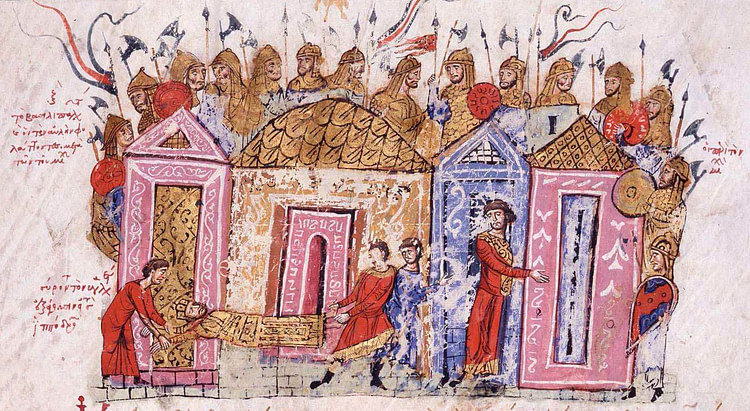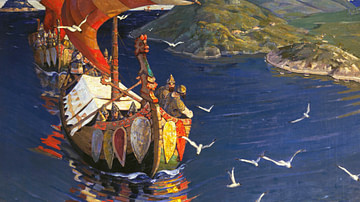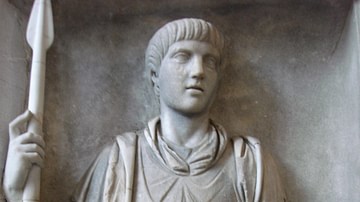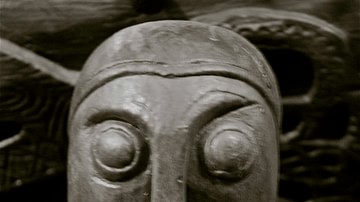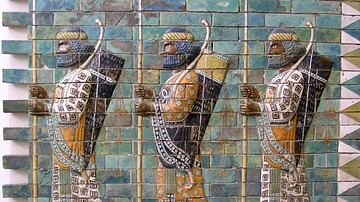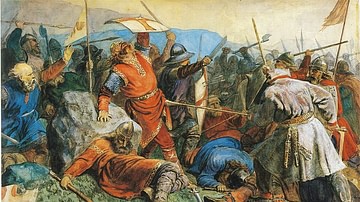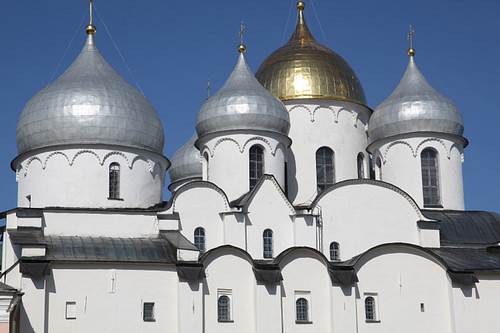
Kievan Rus (862-1242) was a medieval political federation located in modern-day Belarus, Ukraine, and part of Russia (the latter named for the Rus, a Scandinavian people). The name Kievan Rus is a modern-day (19th century) designation but has the same meaning as 'land of the Rus,' which is how the region was known in the Middle Ages.
The Rus ruled from the city of Kiev (also given as Kyiv) and so 'Kievan Rus' simply meant "the lands of the Rus of Kiev". The Rus are first mentioned in the Annals of Saint-Bertin which records their presence in a diplomatic mission from Constantinople to the court of Louis the Pious (r. 814-840) in 839. The annals claim they were Swedes, and this is possible, but their ethnicity has never been firmly established.
The story of the arrival of the Rus in the east is first told in the Primary Chronicle (also known as the Tale of Bygone Years, c. 12th century) of Russia. This work relates how the people of the land invited the Rus (identified as Scandinavian Vikings) to rule and maintain order in their country in the mid-9th century CE. Three brothers, including one named Rurik, accepted the invitation and founded the Rurik Dynasty which would last for over 700 years.
This version of events is supported in the present day by historians who are labeled 'Normanists' (those who accept a Norse origin for the Rurikid Dynasty) and is challenged by so-called 'Anti-Normanists' who argue for a Slavic origin of Russia and the other states. The Normanist claims are presently considered more valid and it is generally accepted that the Norse leader Rurik (r. 862-879) founded the dynasty which would endure, in an unbroken line, through the reign of Ivan IV, first Tsar of Russia (r. 1547-1584) also known as Ivan the Terrible.
The state of Kievan Rus fell to the Mongols between 1237-1242 CE, breaking the region in pieces which eventually developed into the modern states of Belarus, Russia, and Ukraine.
The Primary Chronicle & Early Kings
The Russian Primary Chronicle was probably completed by c. 1113 at Kiev and was once attributed to the monk Nestor (c. 1056-1114) but is now thought to be a compilation of earlier works possibly edited by Nestor. The earliest surviving manuscript dates from 1377 with editorial notes substantiating the earlier date of the work. The Chronicle is regularly alluded to as historical narrative, but this has been challenged as it contains a number of mythic or legendary aspects. Even so, archaeological evidence from the region supports many, though not all, of the events it describes.
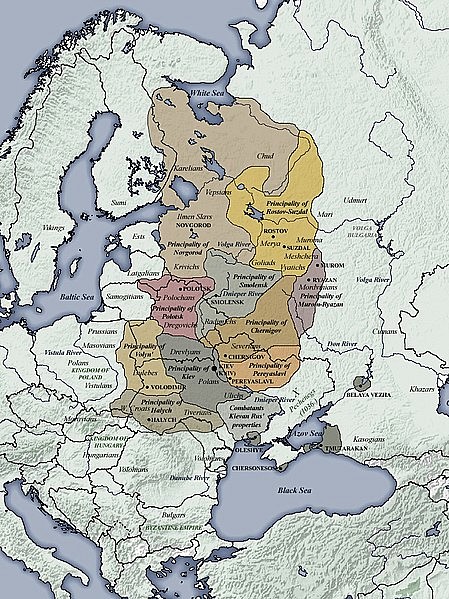
The work begins by claiming that, after the biblical Great Flood, the sons of Noah (Ham, Shem, and Japeth) divided the world between them and Japeth received the region of Kievan Rus as part of his allotment. What Japeth did to establish order in his lands is not mentioned but the Chronicle relates that the people fought with each other and eventually were subjugated by the Khazars of Central Asia (Turkey) and the Varangians (Vikings) of Scandinavia.
The Slavs of the region were forced to pay tribute to the Khazars and the Varangians until they drove the Varangians out but maintained the relationship with the Khazars. Afterwards, however, they found that they could not govern themselves and the tribute paid to the Khazars was too great. Even though they had been tired of paying the Varangians, they recognized that life may have been better under their protection. The Chronicle states:
They said to themselves, "Let us seek a prince who may rule over us and judge us according to the law." They accordingly went overseas to the Varangian Russes; these particular Varangians were known as Russes, just as some are called Swedes, and others Normans, English, Gotlanders, for they were thus named. (59)
The Slavic ambassadors arrived at the unspecified land of the Rus and invited them to come and rule their land as kings. Three noble brothers accepted the invitation and the Chronicle continues:
The oldest, Rurik, located himself at Novgorod; the second, Sineus, at Beloozero; and the third, Truvor, in Izborsk. On account of these Varangians, the district of Novgorod became known as the land of Rus. The present inhabitants of Novgorod are descended from the Varangian race, but aforetime they were Slavs. (59-60)
Corroboration for Scandinavian settlements in these areas comes from physical evidence unearthed in archaeological digs. Around 750 a settlement was established at Staraja Ladoga near the Volkhov River; the first Scandinavian village in the region. Scholar Thomas S. Noonan writes:
Archaeological evidence shows that Scandinavians lived in Ladoga from its inception: a set of Scandinavian-Baltic smithy tools, including a talisman with the face of Odin, was found in a stratum of the 750s…The Scandinavians who visited Ladoga did not come to loot and raid. There were no other towns in the vicinity, monasteries did not exist, and the neighboring burial mounds of the local peoples were very modest in their contents. There was little of value to steal here. Ladoga was created to facilitate access to the interior of European Russia, with all its natural wealth. (Sawyer, 141-142)
The evidence further suggests that Ladoga became a seasonal settlement later or, at least, the population fluctuated which is in line with the Chronicle's narrative of the Slavs ejecting the Varangians and then inviting them back. Norse artifacts have also been found at Novgorod and the other sites mentioned in the Chronicle.
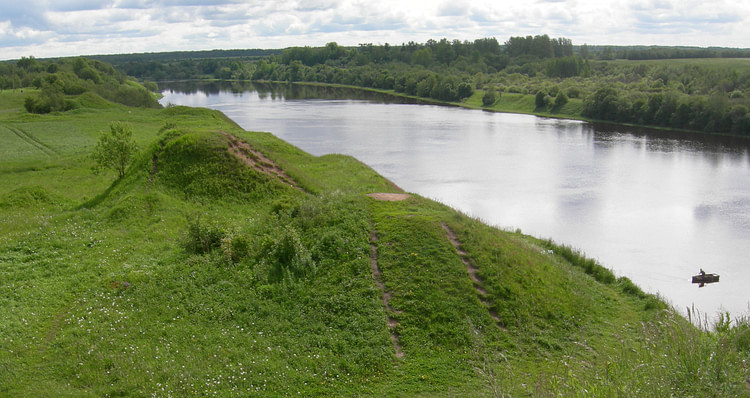
Two years after their arrival, the two younger brothers died and Rurik took their regions as his own with his capital at Novgorod. Two men of Rurik's group, Askold and Dir, asked him for permission to leave the land and seek their fortunes at Tsargrad (Constantinople) and were given leave. On their way to Tsargrad they stopped at a city on a hill called Kiy (Kiev), conquered it, and then began raiding the surrounding area in true Viking fashion. The Chronicle credits them with the famous attack on Constantinople involving 200 Viking ships (c. 860) which was driven off, after much slaughter, by a storm said to have been sent by God; the historical date of this raid, however, does not fit with the rest of the narrative.
In Novgorod, Rurik died of natural causes and entrusted his young son Igor to the care of his kinsman Oleg (also known as Oleg of Novgorod, and Oleg the Prophet, r. 879-912) who succeeded him. Oleg began a series of military campaigns from Novgorod, conquering and consolidating the surrounding lands. He came at last to Kiev and saw how Askold and Dir were amassing enormous wealth through raids.
He tricked them both into coming out of the city, killed them, and took control of the region, moving the capital from Novgorod to Kiev at this time (c. 882). Through negotiations and military strength, he convinced a number of tribes and settlements to stop paying tribute to the Khazars and pay him instead. By the time his reign ended, Oleg had vastly expanded Rus' control of the region and filled Kiev's treasury.
He was known as Oleg the Prophet (which actually translates as Oleg the Priest) due to a prophecy concerning his death. It was foretold that Oleg would be killed by a beautiful horse he owned but which he never dared to ride because of the prophecy. He ordered the horse sent away but provided that it would always be well fed and cared for. Once he had conquered the surrounding regions and made lucrative treaties (especially with Constantinople), he felt confident of his reign, scoffed at the prophecy and asked his advisers what had ever happened to the horse that was supposed to kill him. He was told it had died and Oleg asked to be brought to the horse's bones. Once there, he mocked the prophecy and stamped on the horse's skull – startling a serpent beneath which bit him on the foot and killed him.
He was succeeded by Igor of Kiev (912-945), Rurik's son, whom he had raised. Igor was married to a Varangian woman named Olga (later St. Olga of Kiev, d. c. 969) sometime before he came to power. Like his adopted father, Igor engaged in successful military campaigns and exacted tribute from the conquered. In time, however, he found that all the wealth he had amassed was not enough for him and imposed heavier tribute on the people. He was finally assassinated by the tribe known as the Drevlians for his greed. His son, Sviatoslav I (r. 945-972) was too young to take the throne and so Olga served as his regent between 945-963.
Olga's first order of business was to punish the Drevlians for killing her husband. The Drevlians sent word they wanted her to marry their Prince Mai and Olga seemed to agree and requested emissaries; these she killed by tricking them into being carried in a boat which she then had dumped into a pit and they were buried alive. She then entreated the wisest men of the Drevlians to come to her, invited them to bathe upon their arrival, and set the bath-houses on fire, burning them to death. She then asked the Drevlians to prepare a funeral feast to honor Igor, allowed them all to get drunk, and had her soldiers slaughter everyone there.
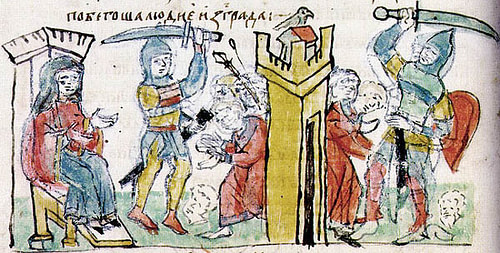
The surviving Drevlians took refuge in the city of Iskorosten, where Igor had been killed, and Olga lay siege to it. When she could not take it, she said she would impose the lightest terms of surrender on the city and asked only for three pigeons and three sparrows from each home. These were quickly given and she had her soldiers attach a piece of hot sulphur by a thread to the birds and then release them to return to their nests in the city. These nests in the eaves of houses, and coops, and elsewhere all caught fire at once and Iskorosten was consumed. Olga killed or sold into slavery most of the survivors but spared others so they could continue to pay tribute.
The stories of Olga's revenge are among the more mythical sections of the Primary Chronicle but are thought to point to actual historical events in the eradication of the Drevlians. These stories were later discounted by the church who made Olga a saint for her dedicated Christian missionary work in the region; even though Kievan Rus remained predominantly pagan throughout the reigns of her son and his successor. It was not Olga but Vladimir the Great (r. 980-1015) who would convert the region to Christianity.
Vladimir the Great & Yaroslav the Wise
Olga abdicated in favor of Sviatoslav I c. 963 and retired to Kiev to spend the rest of her life in domestic duties. Sviatoslav I quickly began a course of military campaigns even greater than those of Oleg and Igor to expand his territory and control trade routes. He conquered Khazaria first, which had long been a rival power, and then the Volga Bulgars, the Alans, and the Danube Bulgars until he had more than tripled his kingdom in size.
He was assassinated returning to Kiev from one such campaign and his sons Yaropolk I (r. 972-980), Oleg, and Vladimir fought for the crown. Oleg was killed and, when Yaropolk I took power, Vladimir fled to Norway to the court of his relative Haakon Sigurdsson (r. c. 972-995). Here he gathered a force of Varangians and bided his time until he felt ready to return and take back the kingdom. He defeated Yaropolk I's armies and killed his brother in an ambush.
Vladimir followed the example of his father and embarked on a number of military campaigns to either expand the kingdom or secure certain areas. Throughout these marches and battles he had pagan shrines erected to honor local or national deities. At about this time (c. 987), Basil II of the Byzantine Empire (r. 976-1025) asked Vladimir for military aid to defend his throne from two challengers (one of whom, Bardas Phokas, had already declared himself emperor). Vladimir agreed and then either asked for, or was offered, Basil II's sister Anne in marriage. The marriage was approved on the condition that Vladimir convert to Christianity.
This pact resulted in the Christianization of Kievan Rus and the establishment of the Varangian Guard in the Byzantine Empire. Vladimir sent 6,000 Varangians to Basil II in Constantinople c. 988 and these would become the elite bodyguard of Byzantine emperors and a formidable body of shock troops from that time until the beginning of the 14th century.
Another version of Vladimir's conversion claims that he had lost faith in his pagan gods and sent emissaries to different nations to talk to the clergy about their religious beliefs and practices. After researching Christianity, Islam, and Judaism he selected Eastern Orthodox Christianity because of the beauty of the churches of Constantinople and there being no prohibition on alcohol or eating pork. This story was created (at some point in the 11th century) most likely to distance Vladimir's conversion from a simple marriage contract and emphasize his independence from foreign influences. Whatever the circumstances of his conversion, it had far-reaching effects as scholar Robert Ferguson notes:
The choice of Slavic and not Old Norse as the language of the Rus Orthodox Church made the process of assimilation irreversible. It also opened up Rus society to the profound and enduring influence of Byzantine culture. (131)
Although he may have initially agreed to convert simply to form an alliance, Vladimir quickly embraced Christianity's best values. He made provision for the poor of his kingdom and made himself personally available to help anyone, no matter their social status. He founded schools to encourage literacy and improved the lives of his people in every respect. Trade flourished and the economy boomed under Vladimir who also founded cities and built numerous churches.
Vladimir was succeeded by Sviatopolk I (r. 1015-1019) known as "the Accursed" for murdering three of Vladimir's sons (including Boris and Gleb, who were later made saints) after coming to power. Sviatopolk I may have been Vladimir's eldest son but this is unclear. His reign was undistinguished and he was deposed by another of Vladimir's sons, Yaroslav I (c. 1019-1054), known as Yaroslav the Wise.
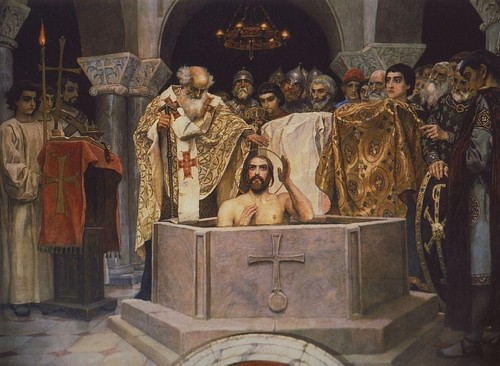
Yaroslav I was the last great monarch of Kievan Rus. He married Ingegerd Olofsdotter (c. 1001-1050), daughter of Olof Skotkonung (r. c. 995-1022), King of Sweden, and later forged important alliances through the marriages of his children to those of other nations. He also reformed the laws, brokered important treaties with Constantinople, and secured his borders from invasions by the nomadic Pechenegs of Turkey. In keeping with the tradition of a Rus king as a warrior, he led a number of successful military campaigns and elevated Kievan Rus to its cultural and economic height. Around 1037, he began construction of St. Sophia's Cathedral in Novgorod, still among the most impressive medieval churches in the world; its opulence is evidence of the grandeur of Yaroslav I's reign.
After his death, Kievan Rus splintered as his sons fought each other for power while other cities and principalities rose in revolt. The succeeding monarchs at Kiev were not strong enough to hold the kingdom together and separate, smaller, polities developed. The Northern Crusades, of the 12th century CE especially, toppled the Baltic region of the kingdom and the Fourth Crusade (1202-1204) ruined trade through the sack of Constantinople, cutting off access to the traditional routes to Greece. By the time of the Mongol Invasion of 1237-1242, Kievan Rus was not even remotely a united federation anymore and the separate states were easily taken.
Kievan Rus in Vikings & Legacy
Kievan Rus was featured in Season 6 of the popular TV series Vikings in 2019 with a focus on the recurring character of Oleg the Prophet (played by Russian actor Danila Kozlovsky). Vikings regularly compressed or combined historical events with some poetic license and the show's depiction of Oleg and various events in the region follows this same course. The inclusion of Kievan Rus was an important development in a show which consistently highlighted the impact Viking raids and migration had on other cultures.
Although the so-called Anti-Normanist historians continue to maintain that Norse influence in the Slavic regions was negligible, physical and literary evidence argues otherwise. The Varangian Rus who settled at Staraja Ladoga, Novgorod, and Kiev established one of the richest and most stable cultures of the time. The development of a national identity with a common religious faith under Rurikid monarchs like Vladimir the Great and Yaroslav I lay the foundation for the countries which would later emerge in the region.
